Is humanity doomed? Doomsday Clock will be updated next WEEK to determine our fate – as the war between Israel and Hamas rages on and climate disasters continue to wreak havoc
Next week, humanity will find out if we are closer to total self-destruction when the Doomsday Clock is updated.
The symbolic clock, which moves closer to midnight to reflect man-made global catastrophes, will be unveiled during a livestream on Tuesday (Jan. 23).
Since last year, the Doomsday Clock has been set to 90 seconds to midnight.
But MailOnline predicts it will get closer to midnight as the war between Israel and Hamas continues, the conflict in Ukraine shows no signs of ending and climate disasters continue to wreak havoc.
Here’s everything you need to know about the Doomsday Clock before it’s updated next week.
Since last year the clock has been set to 90 seconds to midnight, but it is very likely that it will move closer to midnight to reflect the humanitarian catastrophes of the past twelve months.
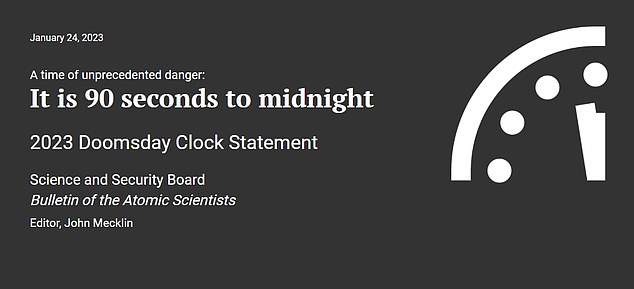
Last year the clock was set just 90 seconds to midnight – the closest to midnight since the first hands were set in 1947.
WHAT IS THE DOOMSDAY CLOCK?
The Doomsday Clock is a symbolic timepiece that shows how close the world is to a man-made global catastrophe, as experts believe.
Every year the clock is updated based on how close we are to the total destruction of humanity (“midnight”).
As the clock moves forward and gets closer to midnight (compared to where it was last year), it suggests that humanity has moved closer to self-destruction.
But as it retreats further away from midnight, it suggests humanity has reduced the risks of global catastrophe over the past twelve months.
Some years the clock hands do not move at all – as was the case in 2021 and 2022 – indicating that the global situation has not changed.
The clock is set by the Bulletin of the Atomic Scientists, a nonprofit organization based in Chicago that publishes an academic journal.
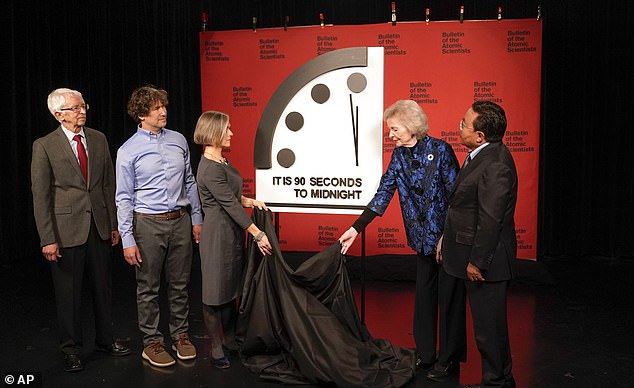
Experts from the Bulletin of the Atomic Scientists remove a cloth covering the Doomsday Clock in Washington on January 24, 2023. Last year the clock went forward to 90 seconds before midnight. It was the closest the Doomsday Clock came to midnight in its entire history
Although it is symbolic and not a real clock, the organization does unveil a physical ‘quarter clock’ model during an event, revealing if and how the hands have moved.
Following the unveiling, the model will be located in the Bulletin offices at the Keller Center, home of the University of Chicago’s Harris School of Public Policy.
WHEN WILL THE DOOMSDAY CLOCK BE UPDATED?
Every January, the Bulletin of Atomic Scientists unveils its annual update of the Doomsday Clock (even if the hands have not moved).
This year, the organization will unveil the hands during a livestream event on Tuesday (January 23) at 10am EST (3pm GMT).
Speakers at the event include Rachel Bronson, president and CEO of Bulletin, and science educator Bill Nye, known in the US for his crazy experiments.
It will be streamed live on the Bulletin from the Atomic Scientists YouTube channel and website.
MailOnline will also cover the announcement live.
WHEN WAS THE DOOMSDAY CLOCK CREATED?
The Doomsday Clock dates back to June 1947, when American artist Martyl Langsdorf was hired to design a new cover for the Bulletin of the Atomic Scientists magazine.
With a striking image on the cover, the organization hoped to “make people afraid of rationality,” according to Eugene Rabinowitch, the magazine’s first editor.
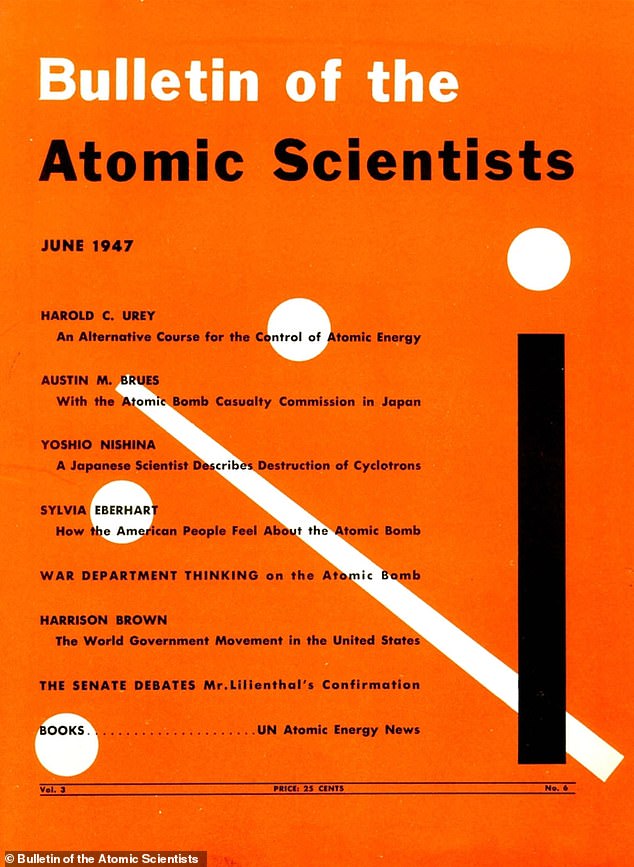
June 1947 cover of the Bulletin of the Atomic Scientists showing the Doomsday Clock at seven minutes to midnight
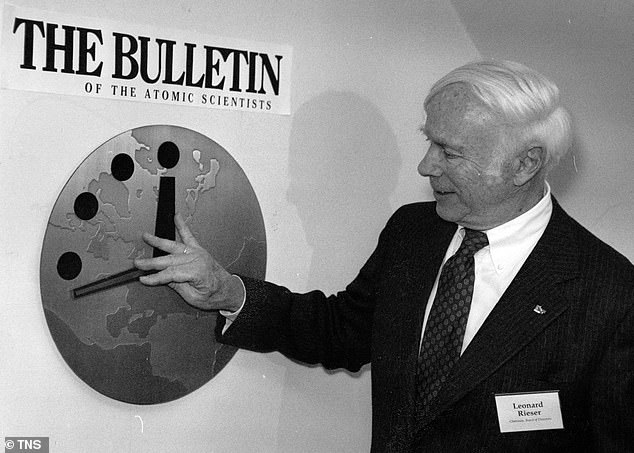
Dr. Leonard Rieser, chairman of the board of directors of the Bulletin of the Atomic Scientists, moves the Doomsday Clock hand back to 17 minutes to midnight in offices near the University of Chicago on November 26, 1991
It happened against a backdrop of public fear around nuclear war and weapons, just two years after the end of World War II.
Langsdorf initially considered drawing the symbol for uranium before sketching a clock to convey a sense of urgency.
She set it for seven minutes to midnight because “it looked good to me,” Langsdorf said later.
On the covers of later issues in subsequent years, the clock hands were adjusted based on how close we are to catastrophe.
In 2009 the Bulletin discontinued its print edition, but the clock is still updated once a year on the website and is now a long-awaited highlight of the scientific calendar.
WHO DECIDES THE TIME?
Shortly after it was first created, Bulletin editor Eugene Rabinowitch decided whether or not the hand should be moved.
Rabinowitch was a scientist who spoke fluent Russian and was a leader in the nuclear disarmament talks, which meant he was regularly in conversation with scientists and experts around the world.
After considering his discussions, he would decide whether to move the clock forward or back.
When he died in 1973, the Bulletin’s Science and Security Board took over, consisting of experts in nuclear technology and climate science.
This included 13 Nobel laureates over the years.
The panel meets twice a year to discuss ongoing world events, such as the war in Ukraine, and whether a reset of the clock is necessary.
WHEN WERE THE HANDS CLOSEST TO MIDNIGHT?
In 2023, the hands were set as close to midnight as possible – 90 seconds – as humanity entered a “time of unprecedented danger.”
The change was largely due to the war in Ukraine and Russia’s threat to use nuclear weapons against Ukraine’s allies.
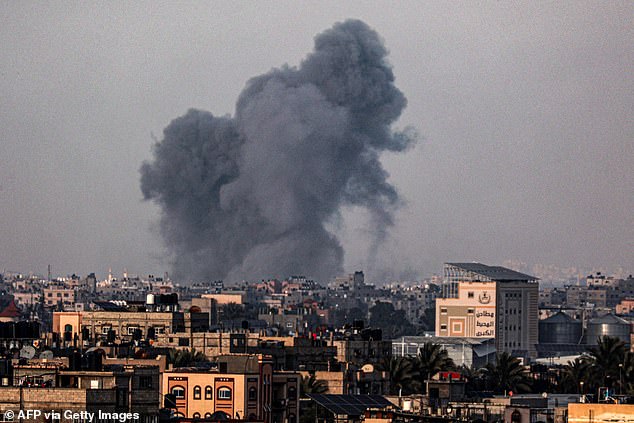
MailOnline predicts the clock could move closer to midnight as the war between Israel and Hamas continues. Photo shows clouds of smoke over Khan Yunis in the southern Gaza Strip during the Israeli bombardment on January 18

The change in 2023 was largely due to the war in Ukraine, which would continue for a second year, according to the Science and Security Council of the Bulletin of the Atomic Scientists.
Before 2023, the hands were as close to midnight as possible in 2020 (100 seconds before midnight).
That was because governments around the world were faced with “two simultaneous existential dangers: nuclear war and climate change.”
When were the hands farthest from midnight?
In 1991, after the end of the Cold War, the Bulletin set the hands to 17 minutes to midnight.
At the end of the war, the US and the Soviet Union signed the Strategic Arms Reduction Treaty.
This meant that countries would reduce their nuclear arsenals, reducing the threat of nuclear war.
WILL THE DOOMSDAY CLOCK REACH MIDNIGHT IN 2024?
When the clock is updated next week, the clock will not yet reach midnight – because this would mean that humanity is on the brink of total annihilation and self-annihilation.
However, it is very likely that the hands will move forward, given the current conflict between Israel and Hamas and the fact that the war against Ukraine has not yet ended.
In 2007, the Bulletin began including catastrophic disruptions due to climate change in its manual deliberations.
Climate is likely to play a role in this year’s decisions as scientists have repeatedly warned about the costs of global warming over the past 12 months.
